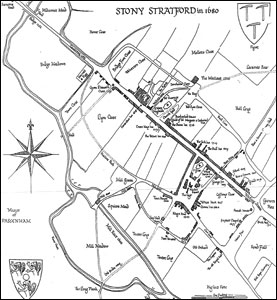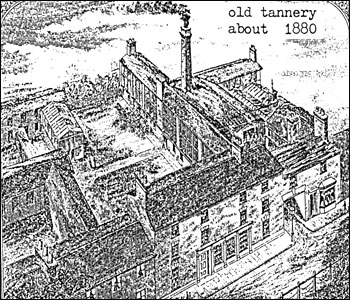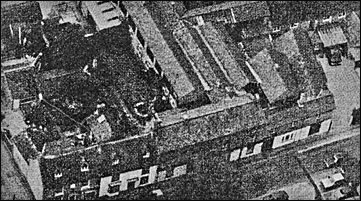 |
 |
 |
|
Sharp & Woollard - Tannery
|
 |
||||||
|
One of the lessons of history is that major industries can evolve into niche sectors as times and tastes change writes Keith Wootton. This is true of the leather processing industry and its changing role is exemplified by the story of Stony Stratford company Sharp & Woollard.
The origins of leather production stretch back to antiquity. Most towns had a tannery to process raw cow skins into leather to make footwear for people and saddles and harnesses for horses. People walked and their shoes wore out quickly so there was greater demand for footwear and repair materials. Other industries relied on leather products, the most significant being the saddle- and harness-making businesses that supported horse-powered agriculture and transport. Any business in Stony Stratford would be well placed to serve these markets, especially in the period before the railways when the number of coaches passing through the town peaked at around 600 a week. The roots of Stony Stratford's leather industry go back to 1600 when the famous Penn family (some of whom later emigrated to found the state of Pennsylvania in the United States of America) purchased land at Stony Stratford in North Buckinghamshire, England. They diverted the river - the Great Ouse - to establish a water mill in one corner of their land and they built a "Tann Yard" on the nearby Harlots Path, quite near to the "Pest Houses." In those days the plague took the lives of many of the town's inhabitants and these would have been the equivalent of an Isolation Hospital. Recorded evidence of the tannery dates from 1712. About 1730 it moved from the original "Tann Yard", across Mill Lane, to become established behind a row of houses towards the west end of Church Street. The business went through a series of ownerships before being aquired by Samual Sharp in 1819. Mr. E. W. Woollard became a partner in 1845, the business thereafter always trading as Sharp and Woollard.
One ingredient required in the curing and tanning process was ammonia and the most readily available source of this pungent chemical in the days before industrialised production was urine. With many pubs and inns along the High Street and around the Market Square of the busy coaching town, there was never a shortage of supply. Pots or tubs were placed at 'convenient' places around the town for use by passers-by (presumably frequented more by the men of the town than the women). The company's records referred to the urine as "stale", perhaps to protect the sensibilities of Victorian and Edwardian population. The company became one of the most distinguished leather dressing firms in the Midlands. It won a special prize at the first Northampton Leather Exhibition in 1873, a significant achievement when one considers that Northampton at that time was a major leather producing and consuming centre. Sharp & Woollard never operated as a tannery to process the raw animal skins. Instead it focused on processing basic vegetable-tanned hides using traditional hand crafts to produce the specialist leather demanded by wholesalers and skilled craftsmen. The UK leather industry was in decline, due initially to the reduction in demand caused by fewer horses in business use, then increased use of synthetic materials and competition from imported goods. However, Sharp & Woollard grew by concentrating on sectors it knew well, attention to quality and customer service and making products for which leather was the only viable material. Its customers included saddlers, harness makers and orthopaedic manufacturers. In the 1930s, the company's shares were divided between the Woollard, Britton (descended from the Sharp family) and Brazell families. Fred Brazell, who joined after the First World War, became managing director and was succeeded by his son Peter, who kindly provided much of the information for this article. He remained at the helm for the rest of the century. The Brazells bought out the other families in the 1960s and 1980s. In 1983 the United Leather Group Ltd., was formed, with Sharp and Woollard Ltd. and the newly established Samuel Sharp (Curriers) Ltd. at Cosgrove being founder members. This later company became the largest exporter of saddlery leather to India, maintaining an office in Kanpur. Two long established family businesses in Walsall and Northampton were aquired in 1987, these also becoming part of the group. Competition continued to increase, especially in Kanpur where there are now more than 200 tanneries and processors, and the UK industry contracted as it became harder to find good-quality rough hides at home. In 1991 Samuel Sharp (Curriers) Ltd. was awarded the Board of Trade Enterprise Development Award. When Peter Brazell approached retirement at the end of the 1990s, the family decided to sell the businesses. In 1998 Sharp and Woollard Ltd. and Samuel Sharp (Curriers) Ltd. were sold to Joseph Clayton and Sons Ltd., a long established tannery in Chesterfield. The two other companies were sold to other leather manufacturers. So ended almost four hundred years of leather manufacture in Stony Stratford. Keith Wootton |
|
|
||
|
|
||
|
|


